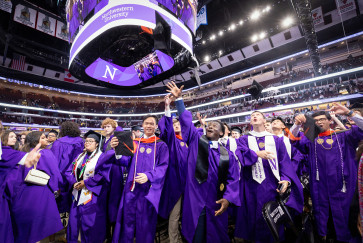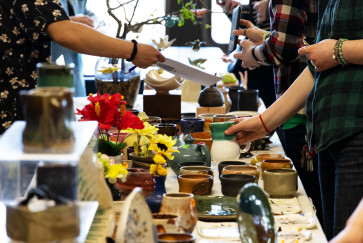Kyle Stephan, the new Steven and Lisa Munster Tananbaum Curator of Modern and Contemporary Art at The Block Museum, was inspired to pursue curatorial work by the realization that art could “do something.”
As a newly minted film studies graduate, Stephan immersed herself in the visual, media and performance art scene of the San Francisco Bay Area in the mid-1990s, a place teeming with art and activism.
While working as the studio manager for artist Lynn Hershman Leeson, Stephan helped organize teams of scientists, engineers, neurobiologists and artists for projects exploring art and technology. The experience showed her the power of art to activate people, advance research and engage communities around a topic to “do something” collective and meaningful. She shifted her focus to curating to continue working with artists and interdisciplinary research.
After completing a Ph.D. in art and art history at Stanford University, Stephan curated the first U.S. survey of Fluxus artist Wolf Vostell at Harvard Art Museums. Vostell, like other avant-garde artists of the Fluxus movement, emphasized process, performance, humor and chance, creating work that embraced the use of everyday objects to make art more available to everyone.
The exhibition leveraged Stephan’s expertise in time-based media (i.e., video, film and performance) and furthered her interest in mining university art collections.
As The Block’s Tananbaum Curator, Stephan will play an integral role in informing and shaping the museum’s exhibitions, collections and public engagement with modern and contemporary art.
Northwestern Now spoke with Stephan about what drew her to The Block Museum and her curatorial plans for the future.
What excites you about working at The Block?
One of the things that attracted me to The Block is its reputation for experimenting with the approach of putting together an exhibition. You can experiment with ways of working that you can’t in more traditional institutions, which is exciting to me.
There are many things that drew me to Northwestern, as well. One is working with the resources and archives here, including the Herskovits Library collections of Africana art. The Northwestern Libraries have incredible Fluxus archives and mid-century music archives I’m excited to dig into. I have taught and curated contemporary performance so the esteemed performance studies department here was another draw. Northwestern with its strengths in music, the performing arts, visual arts and cinema, offers many opportunities for working in this interdisciplinary nexus, which I really enjoy.
What is the curator’s role in helping students and the public engage with the museum’s exhibitions?
An important role is to initiate conversations and inquiry around these works. One way you can do that is by placing unexpected works side by side in the gallery so people can think through new ideas. Another way to do that is by finding contemporary touchpoints for the more historical works.
Programming is integral to the exhibition. Exploring exhibitions together with audiences in the gallery and presenting different disciplinary perspectives on the work can also help the public engage with the artworks.
What are your plans for the near future?
A priority for The Block is to spotlight Chicago and Midwestern artists. As a university museum, we can be an important place of exchange where international audiences can learn about local artists and creative communities. We can also provide local communities with more points of access to other practices that are happening around the world.
I would also like to acquire more art from Latin America, the Caribbean and their diasporas, particularly Latinx work from Chicago. I believe it is important to represent Chicago populations and communities strongly in the collection.


